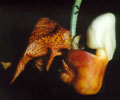|
|
|
|
|
| |
Flasks of
Coryanthes gernotii 'Co#352' × self |
|
| |
|
|
| |
| Number: |
TN3656 |
| Name: |
Coryanthes gernotii 'Co#352' × self
|
| Type: |
self (What's that?) |
|
Seed Donor: |
Dr. Gernot Bergold
|
|
Click to Enlarge

Pod Parent Flower |
|
|
|
| |
Comments: This was the last seed harvested by Dr. Gernot Bergold, the day before he passed away on 5 Feb 2003. It seems fitting that it was from one of the two species of Coryanthes that were named for him (by Gerlach & Romero in 1991).
For additional origin/habitat information supplied courtesy of
Charles and Margaret Baker, see further below, near the bottom of this page.
|
Temperatures we attempt to use in the lab & greenhouse:
| For Species: |
|
Using PSM, Winter, Spring: days average 77°F, nights 63°F; best fit is Intermediate 83-60°F
(Source:
Baker's Web OSC) |
| For Species: |
|
Using PSM, Autumn, Summer: days average 82°F, nights 61°F; best fit is Intermediate 83-60°F
(Source:
Baker's Web OSC) |
|
About the name...
| Etymology of |
Coryanthes |
|
From Greek "korys" helmet; "anthos" flower.
(Source:
Pridgeon 1992) |
| Etymology of |
gernotii |
|
Named for Dr. Gernot Bergold, virologist and orchid enthusiast of Venezuela in the 20th century, who specialized in the genus Coryanthes.
(Source:
Mayr & Schmucker 1998) |
| Pronunciation of |
Coryanthes |
|
ko-ree-AN-theez
(Source:
Pridgeon 1992) |
| Pronunciation of |
gernotii |
|
gair-NOT-ee-eye
(Source:
Troy Meyers) |
|
If you would like to direct someone to this web page, please copy and paste this URL into your email:
http://troymeyers.com/d?013656
| Flask Information |
| Availability: |
We have sold all of the flasks for this item. |
| You should: |
Consider getting individual plants or compots instead of a flask.
You can place a "Notify Flask Recipients" Request, and either we or a flask recipient may contact you when plants are available.
You may also place a "Notify Retries" Request, and if an identical pollination (the same parents) is done again, we'll let you know.
You may reserve a flask, but it's very unlikely you'll get one ...this could only happen if we found a flask that we didn't know we had. |
| Yield Estimate: |
574 plants (based on flask surveys done 02/22/2003 through 07/20/2003)
|
| Plantlet Sizes: |
From many flasks 40 - 80 mm plants (based on flask surveys done 09/10/2003 through 10/13/2003)
From one most recently surveyed flask 60 - 75 mm (10/13/2003)
|
|
You might also want to:
|
View the seed assay for this item.
View items of the same species.
View items of the same genus.
|
| Ordering Information |
| You are not currently logged in. |
|
You must be a registered user and be logged in to reserve a flask or place a notification request. Please log in:
|
|
|
|
|
|
| |
The origin/habitat information below is supplied courtesy of Charles and Margaret Baker
The following information is based on the name of the plant provided by the donor, and assumes that the name is correct. If the plant has been misidentified, then the following information may not be correct.
This text is copyrighted by the Bakers and may not be reproduced without permission.
ORIGIN/HABITAT: Venezuela. Plants were found at about 3300-3950 ft.
(1000-1200 m) along the Rîo Calderas near Calderas in the state of
Barinas. Plants frequently grow in dense, secondary forest in areas with
relatively low humidity. They are always found colonized by ants of either
the genus Crematogaster, which is spread world-wide and harmless, or the
genus Azteca, which is found only in the neotropics and is stingless but
biting and aggressive.
More about this information and the Bakers...
|
|
|
| |
|
|
|